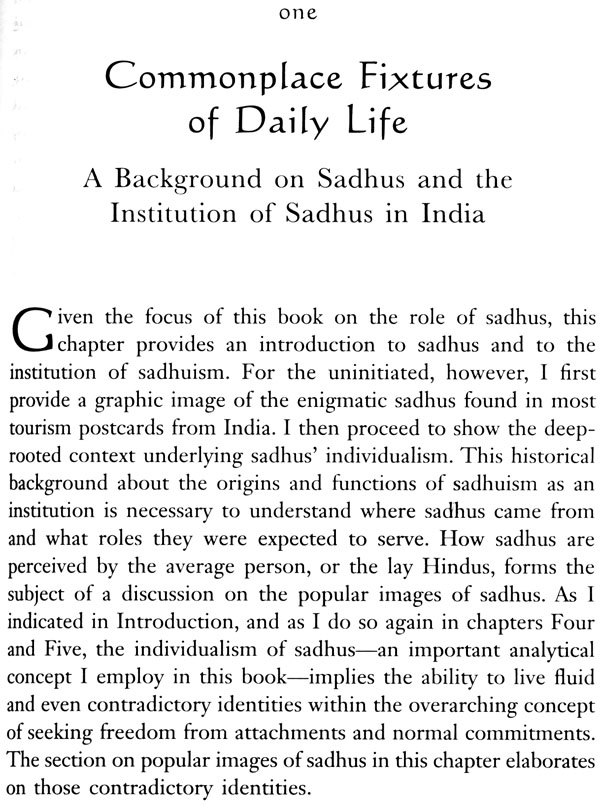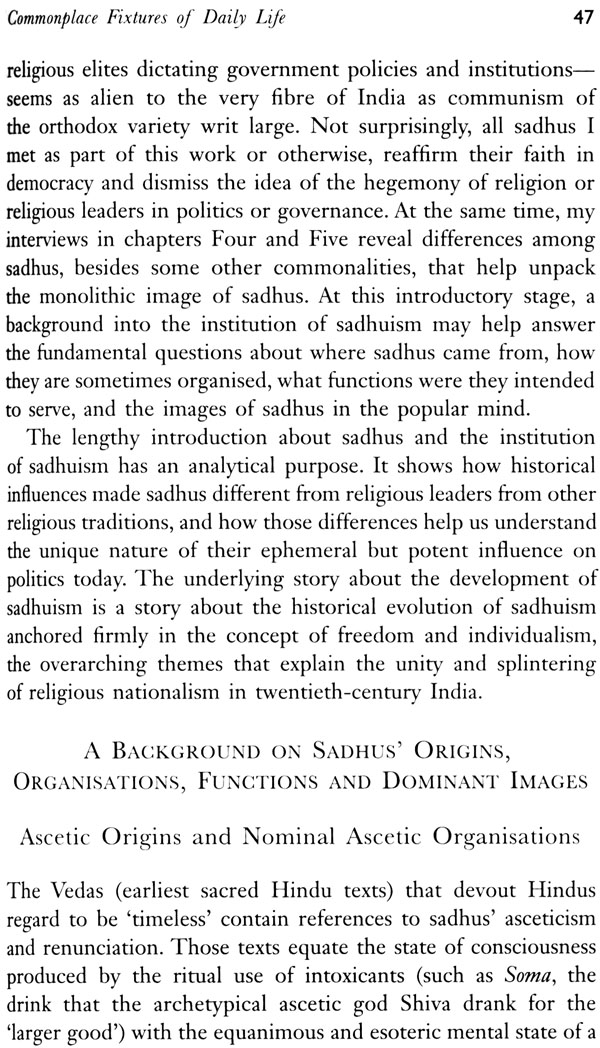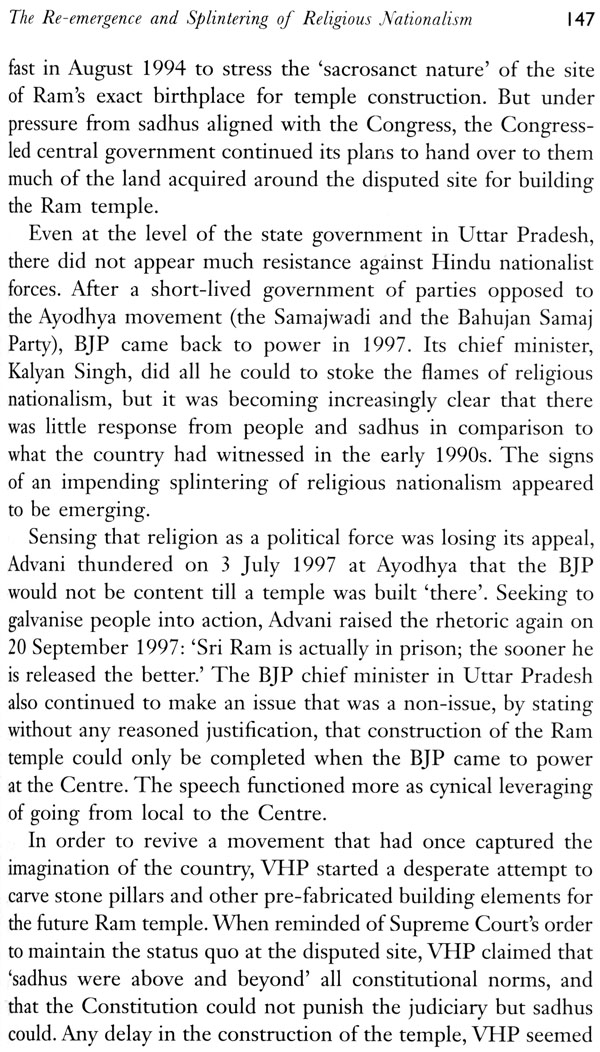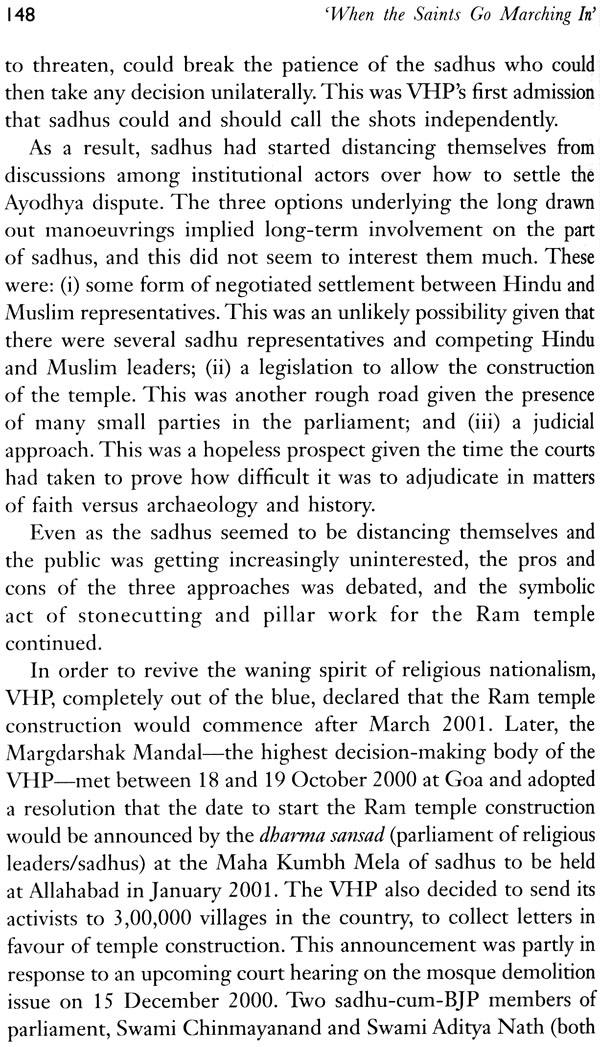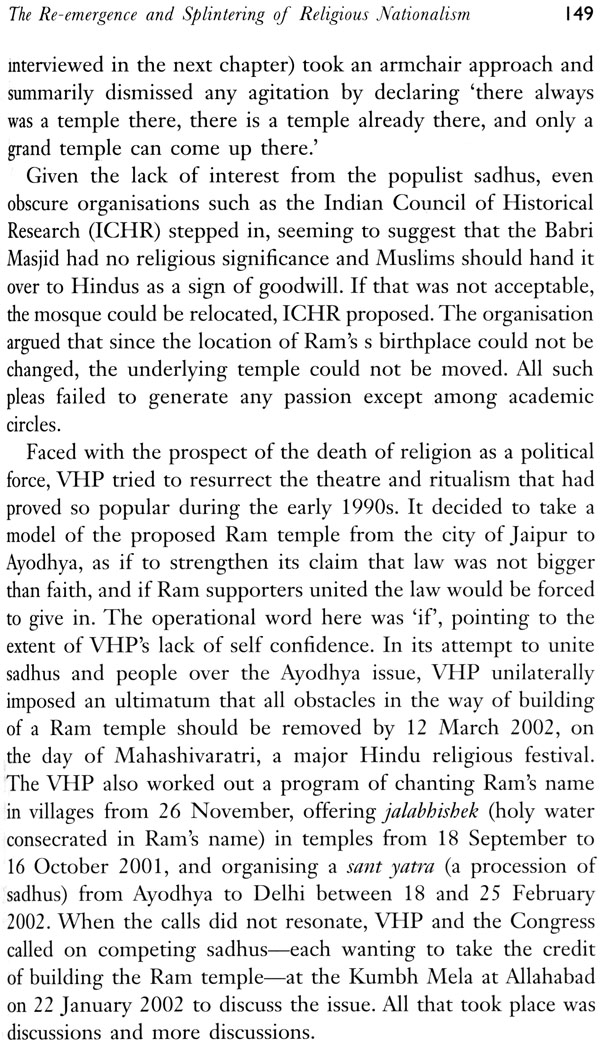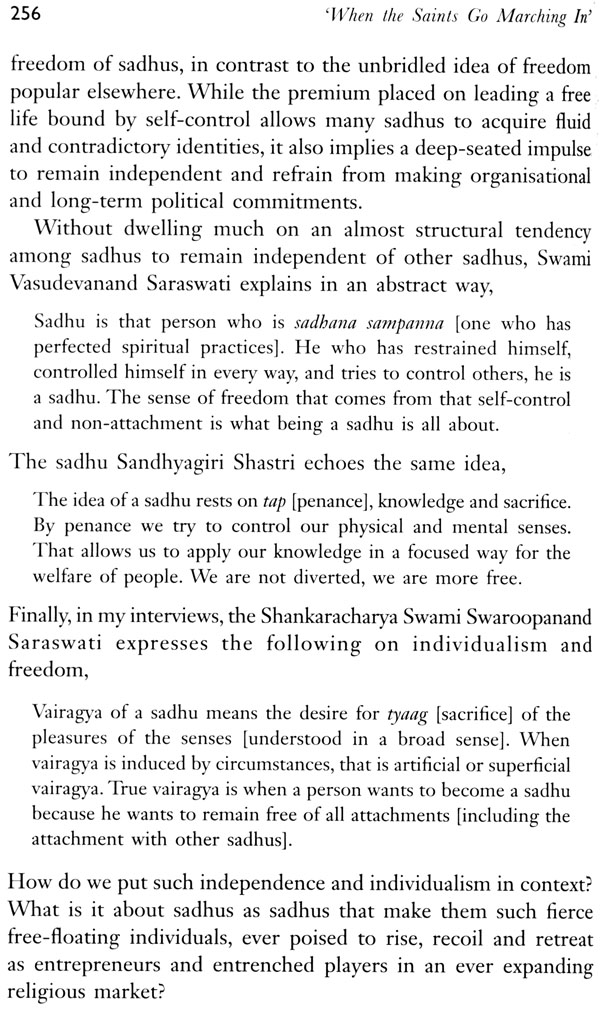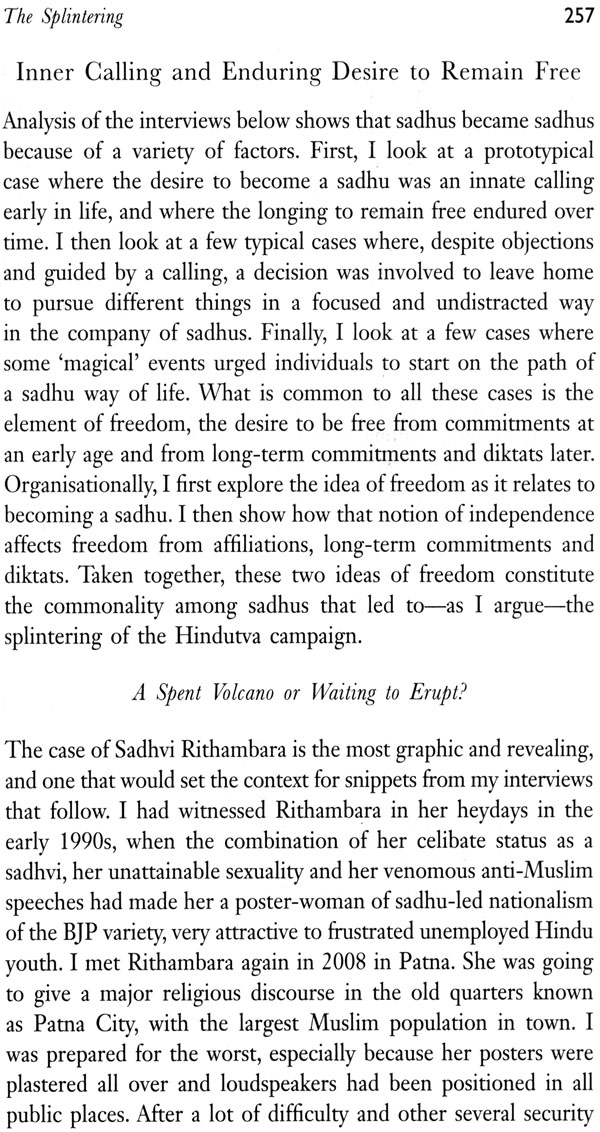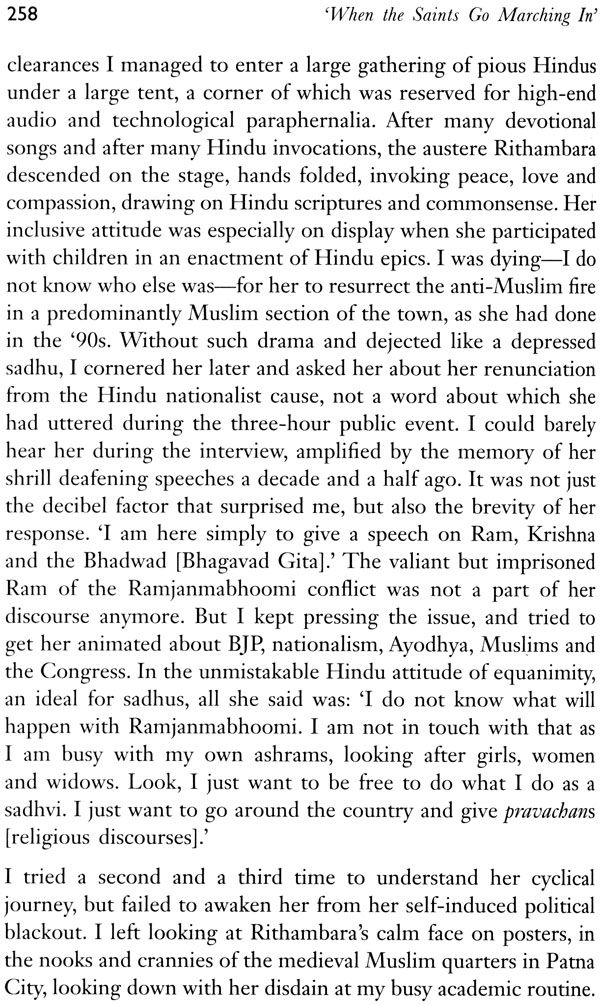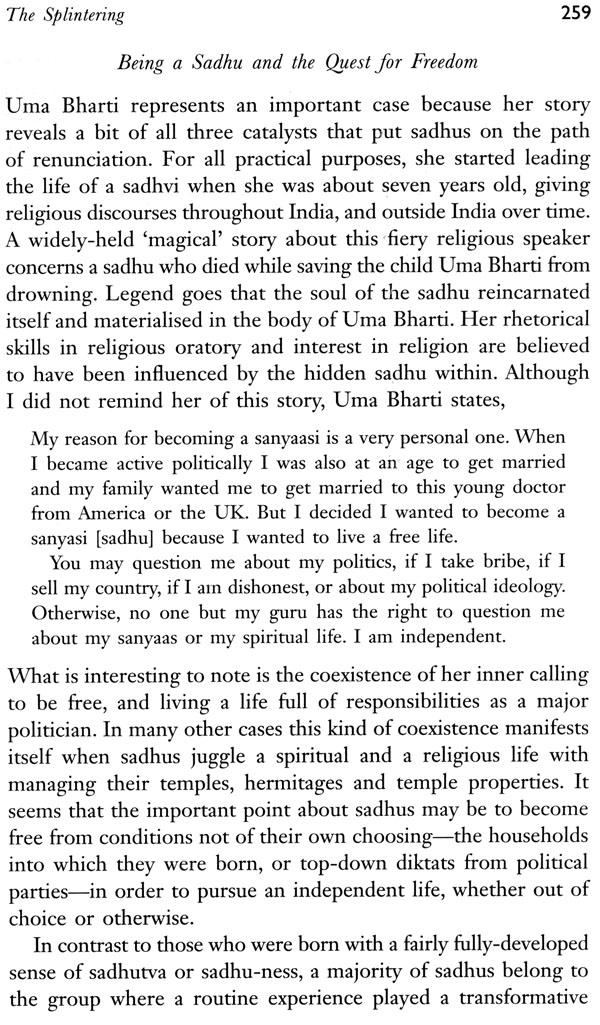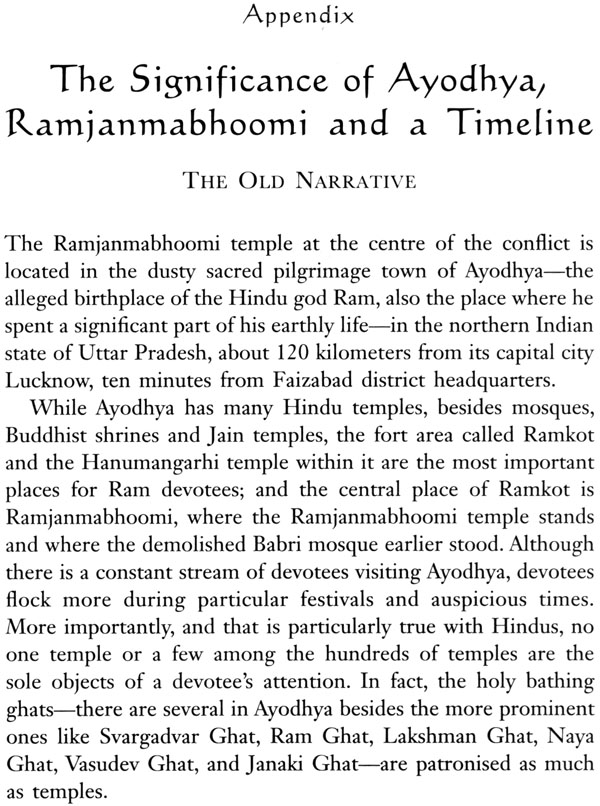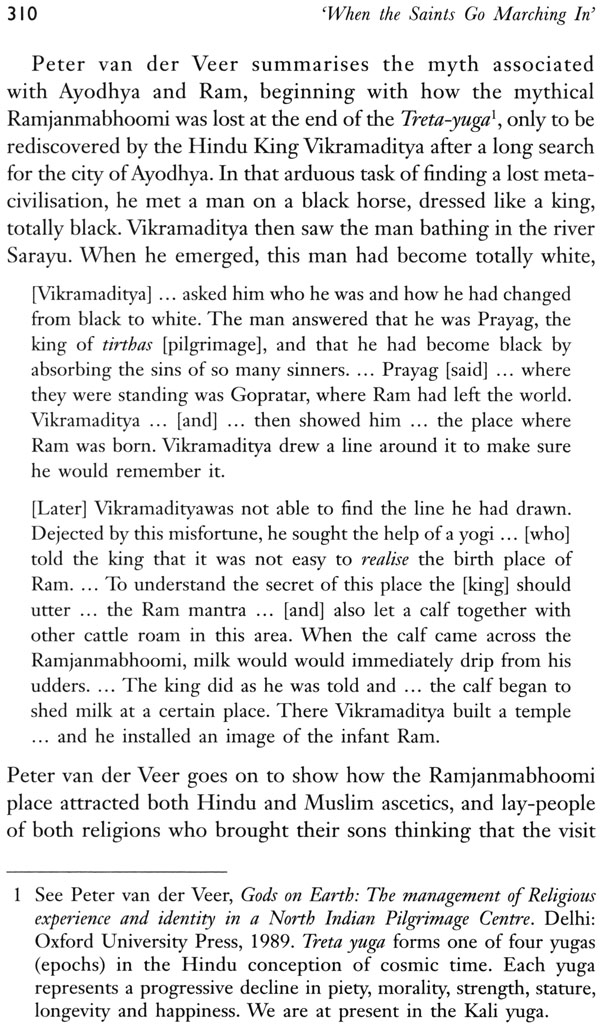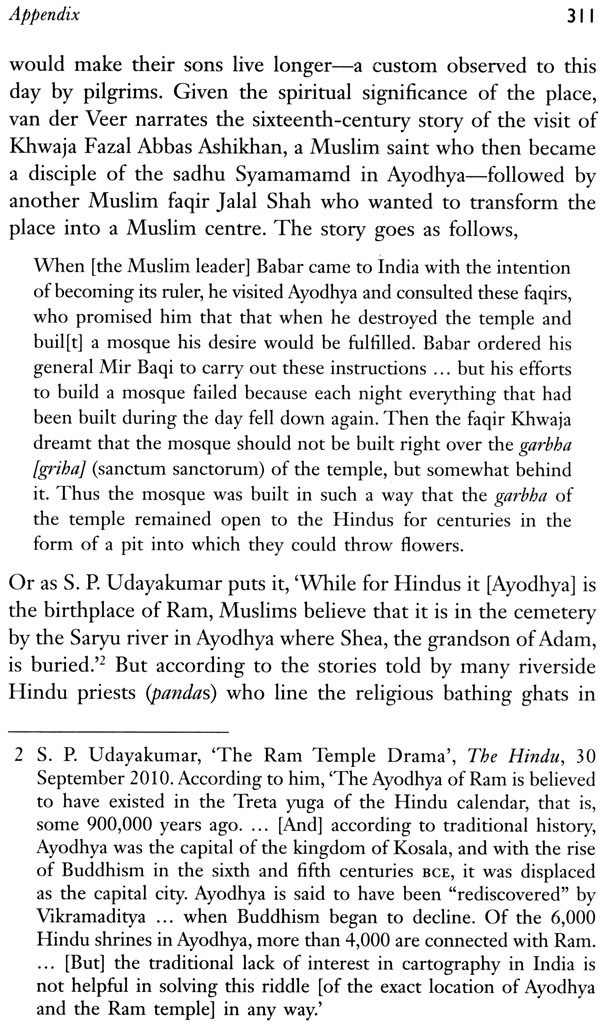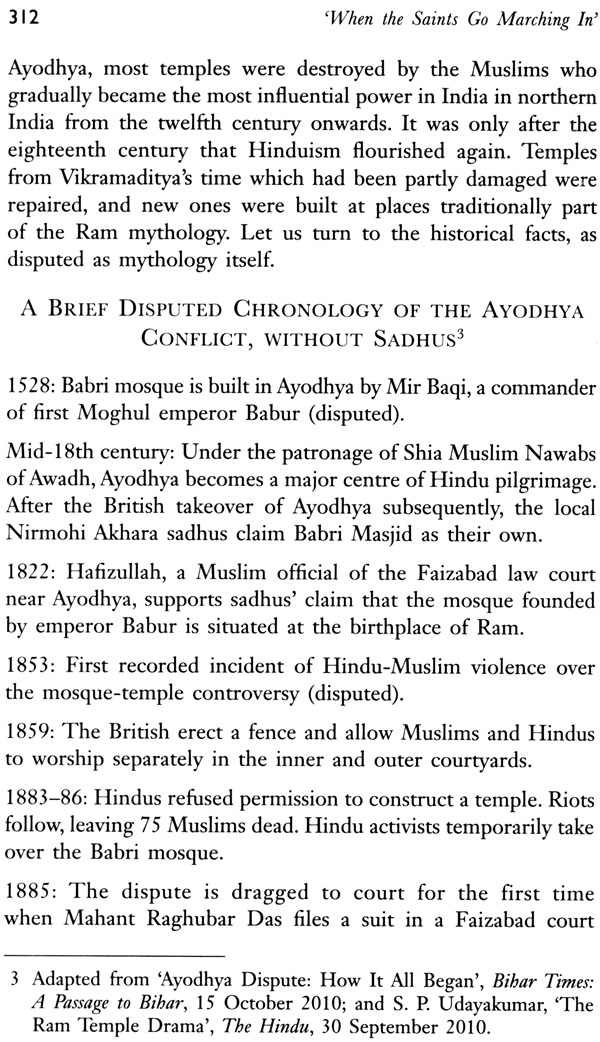
When The Saints Go Marching In (The Curious Ambivalence of Religious Sadhus in Recent Politics in India)
Book Specification
| Item Code: | NAG288 |
| Author: | Rajesh Pradhan |
| Publisher: | Orient Blackswan Pvt. Ltd. |
| Language: | English |
| Edition: | 2014 |
| ISBN: | 9788125052692 |
| Pages: | 324 |
| Cover: | Hardcover |
| Other Details | 9 inch X 5.5 inch |
| Weight | 490 gm |
Book Description
About the Book
India is full of stories of yogis, bursting in saffron on photo-postcards and mundane streets. These are saints who speak in many voices: calm and wise, vitriolic and adversarial, mystical and transcendental. Their non-worldliness sets them apart from the common man. But one event showed the world another face of the quintessential sadhu-that of the political actor. (When the Saints Go Marching In' documents the role played by sadhus in Indian national politics. They came together in 1992 to oversee the Babri-mosque demolition and propelled the BJP into national prominence. Then these sadhus splintered among themselves and with the BJP, and preferred reticence to the spotlight.
What were the factors that caused the theatrical union of these highly- individualistic, strongwilled and eloquent sadhus? How did the sudden splintering in their unity come about soon after 1992?
This volume is based on fieldwork across two decades and presents a unique insight into the mind of ascetics who were active in a political upheaval. By drawing our attention to their inconsistencies, worldliness and their human aspirations as actors in this political drama, this volume breaks the monolithic image of the sadhu that traditional narratives have scripted. This book makes necessary immediate reading, given the penetration of religious fundamentalism and its looming presence in national political life.
About the Author
This book will be an indispensible read for students and scholars of political science and will also be of interest to the lay readers.
Rajesh Pradhan is a writer in the fields of urban planning and political science. Currently, he is on a long-term consulting assignment with the Asian Development Bank, Manila, Philippines.
Introduction
The Book, the Frame, the Political Significance This book is a confluence of three short stories-two visible 1 and a third which is somewhat mythic, invisible and somewhat hidden. It may, therefore, 'seem like the rivers Ganga, Jamuna and Saraswati at Triveni Sangam in Allahabad, India. Like the noisy shallow Ganga on the top of the confluence, you will encounter strident debates here about the role of religion in a secular democracy like India. You will also witness a curious political stirring of social actors (the sadhus) whose claim to fame rests on renunciation of the shallowness of the world. But most important of all, you will get a glimpse of how the deepest identities of committed religious sadhus-identities based on values such as freedom and individualism-tempered the political turbulence in the world they had renounced. These three stories come together in the retelling of the epic story of Ramayana at the end of this book.
While this book may appear as the sum total of three short stories-capped by a reinterpretation of Ramayana at the end-it is not a comprehensive account of religion and politics in India. It is still based on selective facts and selective fictions. This selectivity is justified by the greater purpose of showing the unusual and unusually ephemeral role of certain religious actors in politics. Today-in the Middle East, for instance-when 'moderate' religion seems to be raising its head again, as a reaction against the elite's contempt for democracy and accountability, the curious ambivalence of religious sadhus in Indian politics seems to be a case sue generis, a unique instance of the rise and recoil of 'religious fundamentalists'. It is a story worth telling.'
THE LOCAL STORY AND THE LOCAL CONTEXT, IN BRIEF
What is the political significance of religious leaders in a huge and mature democracy like India? The religious traditions of the majority Hindu community are centred on renouncers, ascetics, monks, swamis and sanyasis-commonly known as sadhus. During the late 1980s and the 1990s, a flurry of sadhu activism coincided with the dramatic rise of a previously insignificant political party, the Bharatiya J anata Party (BJP). As a conservative Hindu nationalist party-a label denied by many in the party-the BJP, allied with many sadhus, came to power at the Centre and in many states, breaking the monopoly that the relatively secular Congress party had held for more than four decades.
The sadhus and the BJP came together over the controversy of whether a Hindu Ram temple, at the exact birthplace of Lord Ram, had been destroyed to build a sixteenth-century mosque'. The conflict (known as the Ramjanmabhoomi or RJB dispute) propelled many religious actors-from a diverse group of reclusive but popular sadhus-to band together and consolidate a fragile victory, engendered by a politically-influenced court judgment that led to the opening of the locks of the disputed temple/mosque. With the temple 'liberated', the Babri mosque became the focus for Hindu nationalists looking to avenge historical wrongs; centred on the eye of a gathering storm, led by colourful sadhus, religious nationalists, BJP and its affiliated organisations. The mosque was destroyed on 6 December 1992, in the presence of many 'transcendent' sadhus, presiding over such worldly affairs as inspiring cheerleaders. In the early 1990s, support for and intensity to build a grand Ram temple was unanimously strong among the sadhus. However, both the coalitions between pro-BJP sadhus and the BJP, as well as the desire to build the temple, unravelled over the next decade. ot only did the newly emergent BJP broaden its political base by distancing itself from a single issue, But the unity among the sadhus also splintered. They failed to overturn the court's stay order against building a Ram temple-the judgment that had led some sadhus to try to consolidate their fragile victory in the first place. Sadhus' inability to rise and mobilise appears to be a puzzle, especially if we consider the judgment of the government-appointed Liberhan Commission, set up soon after the demolition of the Babri mosque.
Set up in December 1992, the Liberhan Commission submitted its ambiguous judgment to Parliament after deliberating for about 17 incredibly long years, on incredibly controversial matters involving faith, mythology and history. The Commission and the state's high court ordered the division of the site of the razed mosque into three parts-two to Hindu institutions and one to the Muslim Sunni Waqf Board. Much to the glee of Hindu nationalists and sadhus, the rulings also declared that the disputed Babri-mosque had been constructed over the remnants of (disputed) Hindu temples lying in utter ruins since much before the sixteenth century when the mosque was built. The ambiguity went further: although the judgment acknowledged the existence of Ram's birthplace 'somewhere' in the disputed mosque-temple complex, it also recognised the modem twentieth- century belief that the birthplace existed right under the central dome of the mosque that had been demolished. And although a court and the Commission affirmed a status quo order, as far as land subdivision and construction were concerned, they also granted the Hindu organisations the right to build (some day) a temple in honour of Ram's birthplace under the dome of the demolished mosque. In May 2011, the Supreme Court legitimised these ambiguous judgments and placed a stay order on land subdivision and construction.
Given these rulings, one would have expected frenzied celebrations among the sadhus and their Hindu nationalist followers. But nothing like that happened. And the fact that representatives of Hindu and Muslim interests were declared joint owners of the disputed premises, that also did not cheer aggrieved Muslims and their secular supporters. What did happen over the 17 years of the Commission's investigation is that the unity of the sadhus splintered, and the BJP became the only national alternative to the Congress party that had monopolised Indian political discourse and the business of rule since 1947.
Instead of focusing on the court's changing stances that led to an unprecedented political eruption at a national level; and instead of looking at the manoeuvrings and vacillations of the BJP as the independent variables-or the primary explanatory factors-this book tries to understand the commonalities and differences among sadhus themselves as factors that explain both the unity among sadhus in one period, and the splintering of that unity in another. That orientation constitutes the entry point for understanding the stories as told here. To put it another way, it elaborates on the idea that the passion and unity among sadhus in building the Ram temple were eventually undermined by three sets of factors: first, the changing outside events and institutions that undermined their cohesion; second, the widely divergent views among sadhus, and third and at the root, the common identity of sadhus as sadhus. Sadhus are individualistic, free-floating, religious individuals who became sadhus not to pursue any social cause as such, but to live a life relatively free of responsibilities and in tune with their inner callings. Diversity among sadhus, turf battles over who will build the temple under what political alliance, the court's changing stances and the vacillating role of political parties are all contributing factors that explain variations in the intensity and strength of sadhu unity over time. But essentially, it is the elements common to the identity of sadhus as sadhus that temper their fundamentalist tendencies. Looking forward, the crouching Hindu serpent, like the famed kundalini in yoga, best characterises this strain of sadhu-led Hindu fundamentalism, ever poised to rise and recoil.'
THE IDENTITY OF THE SADHUS AND THE THEORETICAL ARGUMENT
This book focuses on the identity of a specific type of actors, the sadhus, who can best be summarised as 'spiritual agents'. The 'spiritual' aspect connotes their passionate commitment to a transcendental cause or higher calling-or a commitment to the charisma and magic of orthodoxy-yet which is not aligned in any rigid way to a particular political party or organised religious institution, such as the Church. The 'agent' aspect reinforces not the 'rational agent' idea, but the notion of free- wheeling, individualistic actors whose commitment to inner calling, detachment, independence and freedom overshadow commitments to any particular institution and hierarchy. Freedom, individualism and commitment to transcendental causes or to the magic of orthodoxy accord a high degree of moral authority to such spiritual agents that can shape political outcomes under certain conditions.
Sadhus, therefore, are committed to transcendental causes and have aspirations to act upon them and realise goals that flow from those commitments; yet they do not want to get tied down to a particular institution in pursuit of these causes. But there are some rare moments in history when contingent events help provide a platform for them to come together around the shared transcendental cause and galvanise them into collective action for the duration of the contingent event. Yet, when fissures appear in this contingent coalition or when there are other exogenous pressures or events, the spiritual agents lose patience, disengage or simply move on to their individual spiritual pursuits consistent with their free-wheeling individualistic nature. In this sense, spiritual agents with shared transcendental values constitute a powerful latent force in politics that can come together and disband, depending upon the platform provided by contingent events."
Contents
| Acknowledgements | vii | |
| Introduction: The Book, the Frame, | ||
| the Political Significance | 1 | |
| one | Commonplace Fixtures of Daily Life: A | |
| Background on Sadhus and the | ||
| Institution of Sadhus in India | 45 | |
| two | Sadhus and Religious Nationalism: | |
| Going Back 200 Years or so | 85 | |
| three | The Re-emergence and Splintering | |
| of Religious Nationalism: Sadhus in the | ||
| Ramjanmabhoomi Conflict and Later | 115 | |
| four | On Becoming Sadhus and the | |
| Political Awakening of Sadhus: Conversations | ||
| with the Movers and Shakers | 156 | |
| five | The Splintering: Outside Counter-forces, | |
| Diversity among Sadhus and the | ||
| Common Demolisher Within | 209 | |
| Six | Conclusions and Political Implications | 276 |
| Bibliography | 301 | |
| Appendix | 309 |
